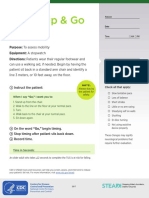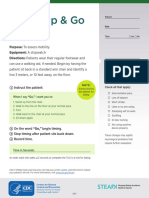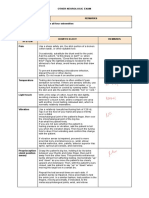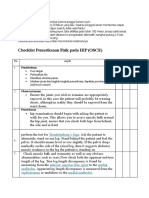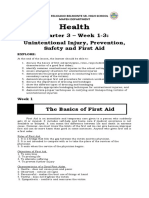N.M. TUG - Test-Print
N.M. TUG - Test-Print
Uploaded by
luCopyright:
Available Formats
N.M. TUG - Test-Print
N.M. TUG - Test-Print
Uploaded by
luOriginal Title
Copyright
Available Formats
Share this document
Did you find this document useful?
Is this content inappropriate?
Copyright:
Available Formats
N.M. TUG - Test-Print
N.M. TUG - Test-Print
Uploaded by
luCopyright:
Available Formats
ASS E SS M E N T
Timed Up & Go
Patient N.M. (19.06.1924.)
(TUG)
Date 20.05.2024.
09:00
Time AM PM
Purpose: To assess mobility
Equipment: A stopwatch
Directions: Patients wear their regular footwear and
OBSERVATIONS
can use a walking aid, if needed. Begin by having the
patient sit back in a standard arm chair and identify a Observe the patient’s
line 3 meters, or 10 feet away, on the floor. postural stability, gait,
stride length, and sway.
NOTE:
1 Instruct the patient: Always stay by
Check all that apply:
the patient for
Slow tentative pace
safety.
When I say “Go,” I want you to: Loss of balance
1. Stand up from the chair. Short strides
2. Walk to the line on the floor at your normal pace. Little or no arm swing
3. Turn. Steadying self on walls
4. Walk back to the chair at your normal pace.
Shuffling
5. Sit down again.
En bloc turning
Not using assistive
2 On the word “Go,” begin timing. device properly
3 Stop timing after patient sits back down. These changes may signify
4 Record time. neurological problems that
require further evaluation.
N.Z. (20.05.2024.) Get up and go test, 15 sekundi uz
Time in Seconds: pomoc pomagala.
An older adult who takes ≥12 seconds to complete the TUG is at risk for falling.
CDC’s STEADI tools and resources can help you screen, assess, and intervene to reduce
your patient’s fall risk. For more information, visit www.cdc.gov/steadi
Centers for Disease Stopping Elderly Accidents,
Control and Prevention 2017 Deaths & Injuries
National Center for Injury
Prevention and Control 2017
You might also like
- Espero at Rutland Fact SheetDocument5 pagesEspero at Rutland Fact SheetCBS Austin Webteam0% (1)
- The Quantitative Myasthenia Gravis (QMG) Test The Manual: (This Manual Is Designed To Accompany The Videotape)Document10 pagesThe Quantitative Myasthenia Gravis (QMG) Test The Manual: (This Manual Is Designed To Accompany The Videotape)Luis Alonso100% (1)
- Timed Up and Go Test RalanDocument1 pageTimed Up and Go Test RalanBagus Andi PramonoNo ratings yet
- Timed Up & Go (TUG) : AssessmentDocument1 pageTimed Up & Go (TUG) : AssessmentScribdMeUpNo ratings yet
- Steadi Assessment Tug 508Document1 pageSteadi Assessment Tug 508alexcoppola777No ratings yet
- BSA Recommended Dix-Hallpike Maneuver TechniqueDocument4 pagesBSA Recommended Dix-Hallpike Maneuver TechniqueAlyssa TangNo ratings yet
- Six Minute Walk Test - Part 2: Nimisha B (MPT, Dyhe) Assisstant Professor Sacpms, MMC ModakkallurDocument20 pagesSix Minute Walk Test - Part 2: Nimisha B (MPT, Dyhe) Assisstant Professor Sacpms, MMC ModakkallurNimisha Balakrishnan100% (1)
- Basic Life Support Worbook v5Document12 pagesBasic Life Support Worbook v5pamiiNo ratings yet
- Tug Test-A PDFDocument1 pageTug Test-A PDFalqurina norizkaNo ratings yet
- 17-2 AlhadariDocument34 pages17-2 AlhadariatgyjppsjxbdvtwdvjNo ratings yet
- 3Q Las Health9 PDFDocument12 pages3Q Las Health9 PDFJairus AbasoloNo ratings yet
- ATLS Notes Amended On 10th June 2018Document18 pagesATLS Notes Amended On 10th June 2018BeaulahNo ratings yet
- Eye MethodsDocument28 pagesEye MethodsWaqar Ul HaqNo ratings yet
- Cara BertaniDocument9 pagesCara BertaniDodi MulyadiNo ratings yet
- Checklist Hip ExaminationDocument7 pagesChecklist Hip ExaminationJavedn100% (1)
- Health 9 Unit 2 3rd QuarterDocument41 pagesHealth 9 Unit 2 3rd Quarterkayessy07No ratings yet
- Checklist Hip ExaminationDocument8 pagesChecklist Hip Examinationhakuna matataNo ratings yet
- FallAssessment PFDocument1 pageFallAssessment PFAnyun NyunNo ratings yet
- START - Simple Triage and Rapid Treatment: MinorDocument7 pagesSTART - Simple Triage and Rapid Treatment: Minorlp2tk tenaga kesehatanNo ratings yet
- RD GuideDocument10 pagesRD GuideRicah Mae AbingNo ratings yet
- Dimension of Development First Aid EducationDocument2 pagesDimension of Development First Aid EducationBagsit Angelique Khryztelle G.No ratings yet
- Head To Toe SurveyDocument4 pagesHead To Toe SurveyKURIMAONGNo ratings yet
- The Precise Neurological ExamDocument30 pagesThe Precise Neurological ExamZīshān FārūqNo ratings yet
- Manual Defibrillation - Information SheetDocument6 pagesManual Defibrillation - Information SheetNurul Juan PratamaNo ratings yet
- Prevention and Treatment of Motion SicknessDocument7 pagesPrevention and Treatment of Motion SicknessDewiNo ratings yet
- Neuro ExamDocument4 pagesNeuro ExamVK LabasanNo ratings yet
- Abnormal Involuntary Movement ScaleDocument3 pagesAbnormal Involuntary Movement Scalemaria putriNo ratings yet
- C&a II Osce CompiledDocument37 pagesC&a II Osce CompiledFaisal MakkiNo ratings yet
- Sensory Examination and CoordinationDocument7 pagesSensory Examination and CoordinationFatimah Alsultan100% (2)
- Firstaid 190724134425Document93 pagesFirstaid 190724134425Nina BachoNo ratings yet
- English For Nursing Topic 3 Nurse Duties in WardsDocument6 pagesEnglish For Nursing Topic 3 Nurse Duties in WardsHerlambang 07No ratings yet
- Quarter III HealthDocument86 pagesQuarter III HealthnggsnigerNo ratings yet
- Mapeh 7: Health AppraisalDocument10 pagesMapeh 7: Health AppraisalEidref NuajNo ratings yet
- Nursing Careplan WeeblyDocument2 pagesNursing Careplan Weeblyapi-379673485No ratings yet
- Telling Daily Activities/Nurse'S DutiesDocument8 pagesTelling Daily Activities/Nurse'S Dutiessindimei alvianiNo ratings yet
- HEALTHDocument6 pagesHEALTHbezz galitNo ratings yet
- Approach To The Patients On Admission in WardsDocument86 pagesApproach To The Patients On Admission in WardsMusabbirNo ratings yet
- ABC - First Aid ManualDocument65 pagesABC - First Aid ManualDitend TeshNo ratings yet
- Northwest Ambulatory AssesmentDocument3 pagesNorthwest Ambulatory Assesmentikfr75undipNo ratings yet
- CG ReviewerDocument4 pagesCG ReviewerAnne NeZhaNo ratings yet
- Kiki Maharani Psik 2A Nurse DutiesDocument7 pagesKiki Maharani Psik 2A Nurse DutiesKiki MaharaniNo ratings yet
- Motor Asssesment ScaleDocument3 pagesMotor Asssesment ScaleDharam PandeyNo ratings yet
- HEALTH 9 HandoutsDocument5 pagesHEALTH 9 HandoutsEfren TuvillaNo ratings yet
- Assessment of NeuroDocument38 pagesAssessment of NeuroumairdammarNo ratings yet
- Preparation: Testing EnvironmentDocument2 pagesPreparation: Testing EnvironmentmufaziaNo ratings yet
- Balance and Falls in ElderlyDocument36 pagesBalance and Falls in ElderlyAkshay BangadNo ratings yet
- (OSCE) (Checklist) Hip ExaminationDocument7 pages(OSCE) (Checklist) Hip ExaminationastarimediantoNo ratings yet
- UntitledDocument81 pagesUntitledClint Howard AsperillaNo ratings yet
- Clinical Exam For OphthalmologyDocument6 pagesClinical Exam For Ophthalmologynuuraaisya67% (3)
- Carpal Tunnel Release SurgeryDocument7 pagesCarpal Tunnel Release SurgeryLaineyNo ratings yet
- NEUROEXAMCHECKLISTDocument5 pagesNEUROEXAMCHECKLISTDarleneNo ratings yet
- Parkinsons Disease Examination OSCE GuideDocument13 pagesParkinsons Disease Examination OSCE Guidedungek30No ratings yet
- Jonathan C. Lubag Unintentional Injuries Q3M1 W1-3Document26 pagesJonathan C. Lubag Unintentional Injuries Q3M1 W1-3Jonathan LubagNo ratings yet
- CPOT OriginalDocument9 pagesCPOT OriginalGaby ChocobarNo ratings yet
- Trauma, Emergency & Basic Life SupportDocument46 pagesTrauma, Emergency & Basic Life SupportCedric MusakalaNo ratings yet
- Checklists For Transfer and AmbulationDocument15 pagesChecklists For Transfer and Ambulationmido100% (1)
- Neurologic Assessment RationaleDocument16 pagesNeurologic Assessment RationaleflorenzoNo ratings yet
- Health Week 1-3 - 3rd QuarterDocument8 pagesHealth Week 1-3 - 3rd QuarterNoemelyn VecinaNo ratings yet
- Skill - 24-4 Assessing Blood Pressure by AuscultationDocument3 pagesSkill - 24-4 Assessing Blood Pressure by Auscultationshereln.ballNo ratings yet
- Neuro Exam ReviewDocument6 pagesNeuro Exam ReviewDianne Flores100% (2)
- EMERGENCY CARE FOR BEGINNERS: Essential First Aid Techniques and Tips (2024)From EverandEMERGENCY CARE FOR BEGINNERS: Essential First Aid Techniques and Tips (2024)No ratings yet
- Living To 100 and Beyond Dl2Document2 pagesLiving To 100 and Beyond Dl2Aziil LiizaNo ratings yet
- Genu ValgumDocument5 pagesGenu Valgumtjr845sjvbNo ratings yet
- International Student Application Form: Personal DetailsDocument2 pagesInternational Student Application Form: Personal DetailsAymen BougueffaNo ratings yet
- 8in1 Hydra Facial Mahine User Manual: Model:FQ077-2Document19 pages8in1 Hydra Facial Mahine User Manual: Model:FQ077-2komaill naqviNo ratings yet
- Head & Neck AnatomyDocument19 pagesHead & Neck Anatomykalemdron87100% (1)
- NSTP CwtsDocument12 pagesNSTP CwtsAdrian Turbolencia50% (2)
- Media Preparation and Methods of InoculationDocument8 pagesMedia Preparation and Methods of InoculationNOEMI BARROGANo ratings yet
- HOPE 3-Quarter 1 (Without Pretest Answer Key)Document45 pagesHOPE 3-Quarter 1 (Without Pretest Answer Key)reymartNo ratings yet
- Administering EnemaDocument35 pagesAdministering Enemabajaoc100% (1)
- Brief Report: Avoidance Extinction As Treatment For Compulsive and Ritual Behavior in AutismDocument7 pagesBrief Report: Avoidance Extinction As Treatment For Compulsive and Ritual Behavior in AutismDavid LedouxNo ratings yet
- Message: Republic of The Philippines Puerto Princesa City Office of The MayorDocument28 pagesMessage: Republic of The Philippines Puerto Princesa City Office of The MayordetailsNo ratings yet
- Herzberg's TheoryDocument10 pagesHerzberg's Theoryapi-3765623100% (2)
- Prevalence and Risk Factors For Myopia Among School Children in Aba (Pdfdrive)Document109 pagesPrevalence and Risk Factors For Myopia Among School Children in Aba (Pdfdrive)Esther AkwuruohaNo ratings yet
- KWL Chart Heart RateDocument1 pageKWL Chart Heart Ratetannya valadezNo ratings yet
- 195865-Article Text-502597-1-10-20201002Document12 pages195865-Article Text-502597-1-10-20201002Wôňđî HäběśhäNo ratings yet
- April 29 8:30AM - Dental Residencies by Mark KodayDocument23 pagesApril 29 8:30AM - Dental Residencies by Mark Kodayjordyn1990No ratings yet
- Bigger Leaner Stronger 5-Day Workout RoutineDocument54 pagesBigger Leaner Stronger 5-Day Workout RoutineCOXNo ratings yet
- Assisted Reproductive TechnologyDocument28 pagesAssisted Reproductive TechnologyftvyvyvNo ratings yet
- Paper NewDocument78 pagesPaper NewmebratumulgetaNo ratings yet
- Case Presentation and Discussion On Dengue: Bedside Rounds OutputDocument5 pagesCase Presentation and Discussion On Dengue: Bedside Rounds OutputCalingalan Hussin CaluangNo ratings yet
- RECOVER Parte 7 Algoritmos y Tabla.Document31 pagesRECOVER Parte 7 Algoritmos y Tabla.Camila Andrea PeñaNo ratings yet
- Brief Narrative Manuel and JulianDocument1 pageBrief Narrative Manuel and Julianivyjeanladlada20No ratings yet
- The Theory of Preventive Stress ManagementDocument13 pagesThe Theory of Preventive Stress ManagementOsama JamranNo ratings yet
- Energy Muscle TestingDocument2 pagesEnergy Muscle Testingsantoshkumar salawadgi0% (1)
- Myp Unit Planner (Lifestyle Choice)Document5 pagesMyp Unit Planner (Lifestyle Choice)roslinawatiNo ratings yet
- CFR Rali WEBDocument2 pagesCFR Rali WEBLuis Rafael Suárez U.No ratings yet
- SwingingDocument5 pagesSwingingapi-272465560No ratings yet
- DialogDocument2 pagesDialogolga millatNo ratings yet
- BangladeshDocument1 pageBangladeshMohammad BelalNo ratings yet


